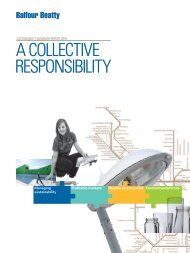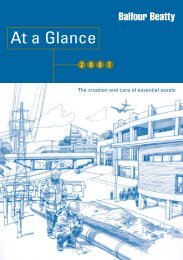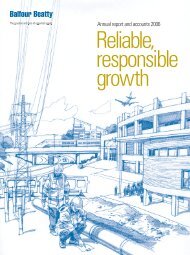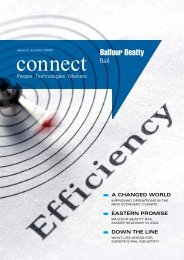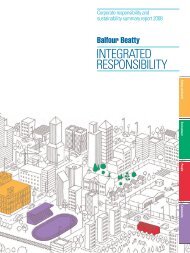Sustainability Report 2011 - Balfour Beatty Rail
Sustainability Report 2011 - Balfour Beatty Rail
Sustainability Report 2011 - Balfour Beatty Rail
Create successful ePaper yourself
Turn your PDF publications into a flip-book with our unique Google optimized e-Paper software.
Managing sustainability<br />
Global issues<br />
Collectively, the global construction and property sector has significant<br />
economic, social and environmental impacts, in ways that are both positive<br />
and negative. These impacts also provide opportunities for <strong>Balfour</strong> <strong>Beatty</strong><br />
to make a real difference to people’s lives.<br />
Why this matters to us<br />
The sector as a whole accounts for:<br />
• 30% of the world’s waste<br />
• 40% of global energy use and a third of global greenhouse<br />
gas emissions<br />
• 30% of the world’s consumption of natural resources and<br />
• 20% of water use.<br />
Buildings are responsible for up to 80% of greenhouse gas<br />
emissions in our towns and cities. Reducing these emissions in<br />
the built environment is widely recognised as the least expensive<br />
method of abating the adverse impacts of climate change.<br />
In socio-economic terms, the built environment has significant<br />
direct and indirect impacts on social wellbeing and the livelihoods<br />
and prosperity of communities and individuals. The sector is a<br />
major employer, with a diverse and complex supply chain,<br />
positively impacting local economies through jobs, training and<br />
industry. The sector provides homes, education, healthcare,<br />
transportation and recreational facilities for communities.<br />
Source: GRI Construction and Real Estate Supplement, <strong>2011</strong><br />
www.globalreporting.org<br />
Global trends relevant to <strong>Balfour</strong> <strong>Beatty</strong><br />
In 2008, in conjunction with Forum for the Future, we identified<br />
the issues likely to be critical to the continued global success of<br />
our business from a sustainability perspective. The priority areas,<br />
identified through horizon-scanning techniques, included:<br />
• The availability and cost of raw materials and water as<br />
populations grow and key natural resources dwindle. This<br />
will impact the way we manage waste, source our materials<br />
and conserve water resources, while also presenting new<br />
commercial opportunities such as water and waste water<br />
treatment technologies.<br />
• The physical and economic impacts of climate change are likely<br />
to increase over time. This is likely to increase investment in<br />
adaptation and encourage more innovative ways of managing<br />
existing assets being impacted by climate change.<br />
• Globalisation and the rise of the BRIC (Brazilian, Russian,<br />
Indian and Chinese) economies impacting on the demand<br />
for infrastructure and other business opportunities.<br />
• Increasing costs of fossil fuel energy and the price of carbon<br />
will encourage us and our customers to seek low-carbon<br />
opportunities to reduce costs, increase security of supply<br />
and potentially profit from carbon trading.<br />
• The availability of finance could determine investment priorities<br />
and hence the size and nature of future market opportunities<br />
• The attraction and retention of skilled workers will be<br />
influenced by their perception of which businesses respond<br />
effectively to their corporate responsibilities, including the<br />
availability of opportunities to make a real difference to<br />
society’s sustainability challenges.<br />
14<br />
These issues helped to underpin the development of our 2020<br />
sustainability vision and roadmap which was launched in 2009<br />
and will be revisited in future updates of the roadmap in 2012.<br />
Opportunities<br />
Although there are many uncertainties over the next decade, this<br />
horizon-scanning exercise highlighted major opportunities for<br />
<strong>Balfour</strong> <strong>Beatty</strong> in the transition to a greener economy. For example:<br />
• An estimated market in the low-carbon economy of over<br />
£200bn over the next decade in the UK alone through transition<br />
to more renewable energy such as wind, tidal and solar power,<br />
new nuclear, waste-to-energy plants and upgrading of the<br />
transmission network<br />
• Continued growth in the construction and renewal of<br />
rail infrastructure<br />
• Increased demand for zero carbon and more sustainable<br />
buildings – both new and the refurbishment of existing building<br />
stock (the green retrofit market in the UK alone is estimated at<br />
£10bn per annum and in the USA Executive Order 13514 requires<br />
a 30% energy reduction across the Federal estate by 2025)<br />
• Development of carbon capture and storage at power<br />
generation plants<br />
• Continuing demand for more sustainable social housing, schools<br />
and hospitals, as global populations continue to grow.<br />
For further details of our success in the growing<br />
green economy, go to P27 – P38<br />
Our plans for 2012<br />
We will conduct another full horizon-scanning exercise in<br />
conjunction with Forum for the Future to help inform the<br />
development of new 2015 targets for our sustainability roadmap.<br />
<strong>Balfour</strong> <strong>Beatty</strong> <strong>Sustainability</strong> <strong>Report</strong> <strong>2011</strong>







